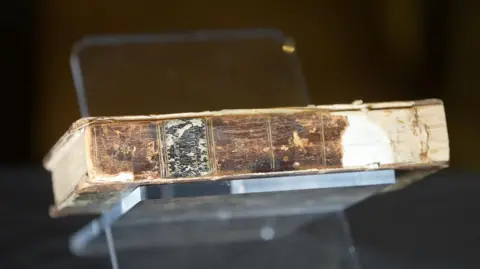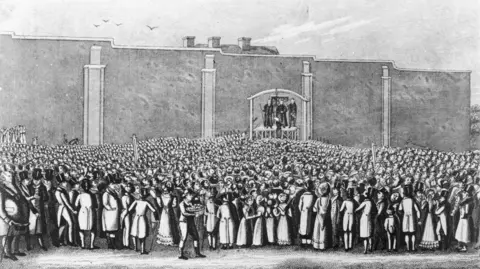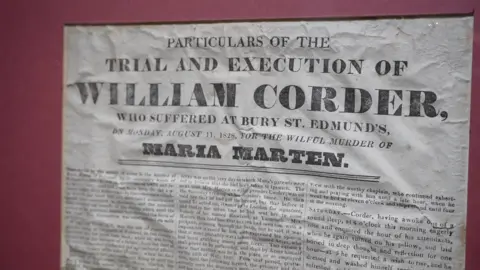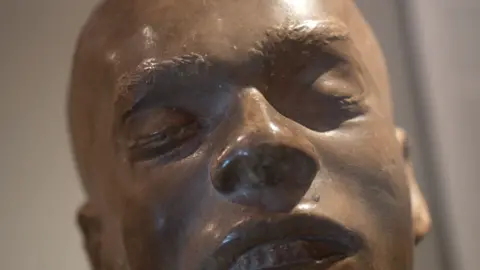Who was the murderer whose skin binds a book?
 BBC/Jamie Niblock
BBC/Jamie NiblockThe cover of a book held at a Suffolk museum was recently found to be made from the skin of a man hanged for a notorious murder almost 200 years ago.
William Corder was convicted of killing a woman in 1827, which shocked Georgian Britain and became known as the Red Barn Murder.
Curators at Moyse's Hall Museum in Bury St Edmunds realised the book, which was on a bookshelf in an office, had been overlooked but it has now gone on display.
It had been donated decades ago by a family with close connections to the surgeon who anatomised Corder's body.
So what do we know of William Corder and the murder, which fascinates to this day?
Who were William and his victim Maria?
 Getty Images
Getty ImagesWilliam was from a middle-class family of tenant farmers in the village of Polstead, between Ipswich and Sudbury, at the turn of the 19th Century.
At the age of 22, when he and Maria Marten became lovers, he was the head of the Corder family and had a reputation as a ladies' man. Maria, who was 24 and lived at home with her mole-catcher father, a stepmother, sister, and her young son, may have seen young William as a means of escape.
In 1827, William came up with a plan to elope, telling Maria to meet him at the Red Barn on the Corder's farm, then run off to Ipswich to get the banns for their wedding.
Maria was not seen again and William disappeared.
 Getty Images
Getty ImagesWhat happened next?
William eventually left Suffolk and wrote to the Marten family to say he had eloped with Maria to the Isle of Wight.
In reality, he was holed up just outside London and Maria was buried at the lovers' rendezvous, having been shot in the neck.
Almost a year later, legend states, Ann Marten had a dream her stepdaughter was dead and at the Red Barn. Maria's father dug with his "mole spud" spade and found his daughter's remains.
As a manhunt ensued, a newspaper editor flagged that he knew of a William Corder.
"He is effectively on the run, and the theory is he's lonely, and puts an advert in the newspaper asking for a new wife," says Dan Clarke, a heritage officer at Moyse's Hall Museum. It holds many Red Barn Murder artefacts, including two books covered in Corder's skin.
The authorities traced Corder, who denies any knowledge of Maria, but has a letter from Polstead telling him her body has been found.
The trial and public hanging
 Getty Images
Getty ImagesCorder was brought to Bury St Edmunds on 10 counts of murder, each based on a different theory about Maria's demise and to strengthen the chance of a conviction.
In his defence he claimed Maria had killed herself, thereby accusing the dead woman of a capital crime. He was found guilty after a two-day trial, and in a final confession said he had accidentally shot Maria during an argument.
It is estimated 7,000 to 10,000 people came to see him hanged outside the prison at the stroke of noon on 11 August 1828. Later that day, people queued to file past his body at the town's Shire Hall.
"There were so many people, the story goes they couldn't get him outside the prison, so they had to hit a hole in the side of the building and create a temporary scaffold," said Mr Clarke.
"There would have been singing and dancing, you would have been able to buy a section of the rope afterwards."
Polstead became a tourist attraction, the Red Barn and even Maria's gravestone chipped away by souvenir-hunters.

Corder's legacy

Public intrigue in the Red Barn Murder sparked books, plays and music, and it permeates the true crime culture to this day.
At a distance of two centuries, it has become a ripping yarn, the true story clouded in legend.
It is probably fuelled, in part, by being able to stand face-to-face with Corder's image, his eyes shut and his nostrils flared. His death mask is held at Moyse Hall and Norwich Castle.
For many years, until it eventually began to fall apart, his skeleton was used to teach medical students at West Suffolk Hospital.
Disturbingly, two books were covered in his skin and part of the man's scalp, with ear included, was kept as a gruesome ornament. All are at Moyse Hall.
Terry Deary, who created Horrible Histories, believes Corder has been "maligned" with Maria incorrectly portrayed as an innocent young maiden.
Moyse's Hall said it would redress the focus on Corder with a future exhibition which will shine a light on woman victims in Suffolk history, including Maria.
Heritage assistant Abbie Smith said 80% of its visitors were "desperate" to know about the Red Barn Murder.
"How it ended is a big factor, it was such a spectacle and people are going to be drawn to it.
"It's a gory, grotty one, so people seem to like that - rather worryingly."
Follow Suffolk news on BBC Sounds, Facebook, Instagram and X.
